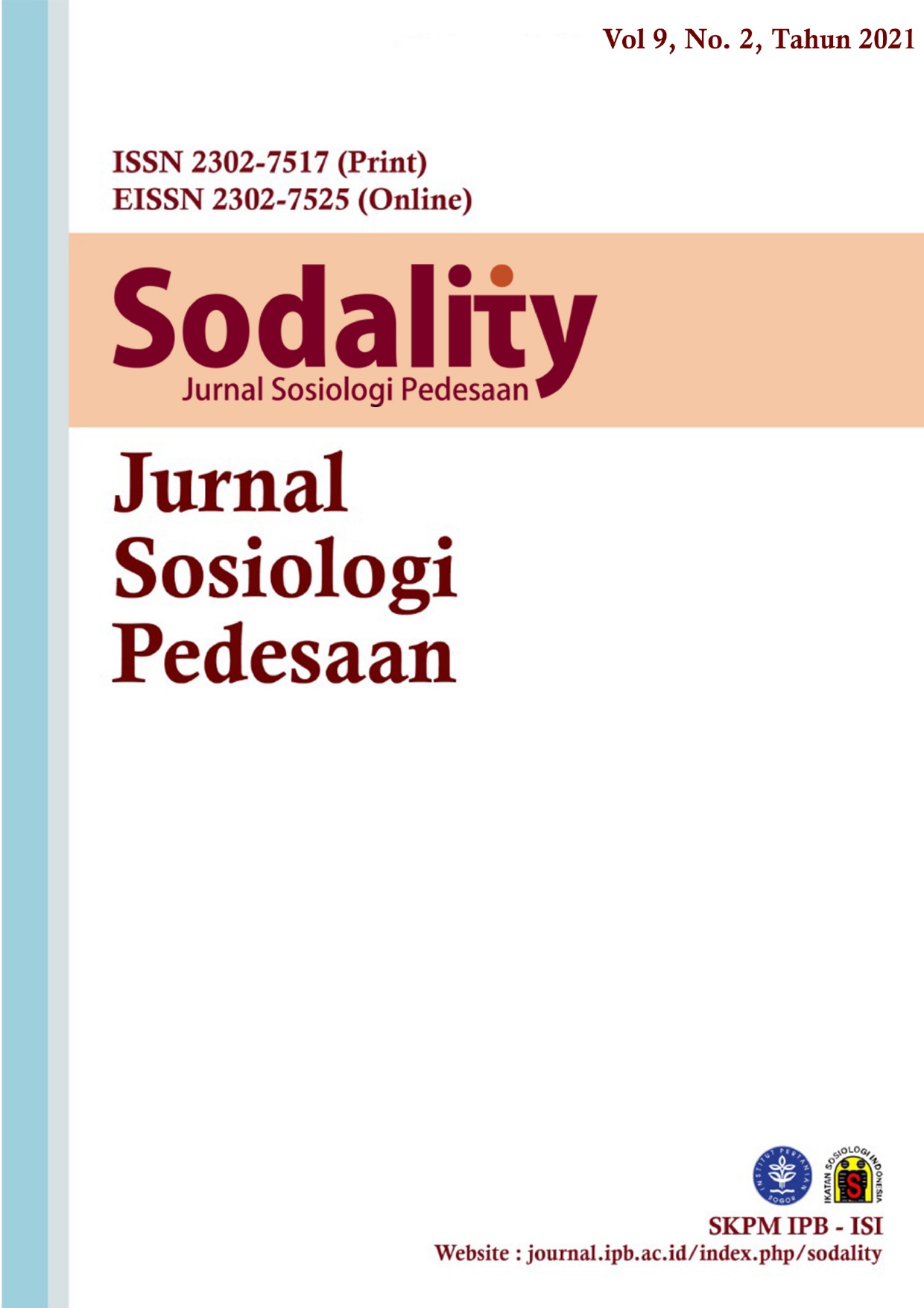The Urgency of Institutional Development of Cassava Industry in Daerah Istimewa Yogyakarta and Jawa Tengah
Abstract
The study shows that there was variation in the process of cassava-based food production. In Daerah Istimewa Yogyakarta (DIY) and Central Java, the farming systems were still subsistence oriented as the members still carried out traditional farming and worked without practicing intensive farming. However, the cassava-based food processing had already been commercially oriented. Some farmers have successfully collaborated with the larger cassava industry who were profit and commercially oriented. Some agribusiness units required specific varieties, but others opened to any varieties of cassava. The various arrangements have created different patterns of partnership. There were three types of business partnerships namely (1) growers and small-scale manufacturers; (2) partnership among growers, raw material processors, food manufacturers, and distributors or sellers; and (3) partnership among growers, small or large manufacturers and distributors or sellers. Among those three patterns, some enterprises had already performed a business-oriented processing method and quality assurance which requires best quality of raw cassava. This is resulted in a better selling price. Business partnerships can guarantee the sustainability of business relationships among business units. A better upstream-downstream relation needs to be developed to prevent the risks of raw materials supply.
References
Andriani, I., Iswandi, R. M., & Abdi, A. (2018). Analisis Peranan Dan Manfaat Kemitraan Usaha Singkong. Jurnal Ilmiah Agribisnis (Jurnal Agribisnis Dan Ilmu Sosial Ekonomi Pertanian), 3(3), 59–63.
Cao, M., & Zhang, Q. (2013). Collaborative Advantage as Consequences. In: Supply Chain Collaboration. In Supply Chain Collaboration (pp. 77–91). Springer.
Carney, D. (2002). Sustainable Livelihoods Approaches: Progress and Possibilities for Change.
El-sharkawy, M. A. (2004). Cassava biology and physiology (2003).pdf. 621–641.
FAO. (2019). Saving Lives with Safer Food. http://www.fao.org/indonesia/news/detail-events/en/c/1197200/
Flåten, B. T., Isaksen, A., & Karlsen, J. (2015). Competitive firms in thin regions in Norway: The importance of workplace learning. Norsk Geografisk Tidsskrift, 69(2), 102–111. https://doi.org/10.1080/00291951.2015.1016875
Grillitsch, M., & Nilsson, M. (2015). Innovation in peripheral regions: Do collaborations compensate for a lack of local knowledge spillovers? Annals of Regional Science, 54(1), 299–321. https://doi.org/10.1007/s00168-014-0655-8
Habersetzer, A., Grèzes-Bürcher, S., Boschma, R., & Mayer, H. (2019). Enterprise-related social capital as a driver of firm growth in the periphery? Journal of Rural Studies, 65(April 2017), 143–151. https://doi.org/10.1016/j.jrurstud.2018.10.009
Herbig, P. A., & O’Hara, B. S. (1994). The Future of Original Equipment Manufacturers: A Matter of Partnerships. Journal of Business & Industrial Marketing, 9(3), 38–43. https://doi.org/10.1108/08858629410066854
Jamali, D., Yianni, M., & Abdallah, H. (2011). Strategic partnerships, social capital and innovation: Accounting for social alliance innovation. Business Ethics, 20(4), 375–391. https://doi.org/10.1111/j.1467-8608.2011.01621.x
Koçoǧlu, I., Imamoǧlu, S. Z., Ince, H., & Keskin, H. (2011). The effect of supply chain integration on information sharing: Enhancing the supply chain performance. Procedia - Social and Behavioral Sciences, 24, 1630–1649. https://doi.org/10.1016/j.sbspro.2011.09.016
Neuman, L. (2009). Social Research Methods: Qualitative and Quantitative Approaches (7th ed.). Pearson.
Niehof, A., & Price, L. (2001). Rural livelilihood systems: A conceptual framework (UPWARD Series on Rural Livelihoods No.1 WUUPWARD).
Nugraha, H. D., Suryanto, A., & Nugroho, A. (2015). Kajian Potensi Produktivitas Ubikayu (Manihot esculenta Crant.) di Kabupaten Pati. Jurnal Produksi Tanaman, 3(8), 673–682.
Putsenteilo, P., Klapkiv, Y., Karpenko, V., & Gvozdecka, I. (2020). The role of institutions in the development of agriculture. Bulgarian Journal of Agricultural Science, 26(1), 23–33.
Rezaei, J., Ortt, R., & Trott, P. (2015). How SMEs can benefit from supply chain partnerships. International Journal of Production Research, 53(5), 1527–1543. https://doi.org/10.1080/00207543.2014.952793
Rianto, H., Historiawati, H., & Iftitah, S. N. (2020). Pengelolaan Pertumbuhan Daun Ubikayu (Manihot esculenta Cranzt) Melalui Mulsa Jenis Kultivar dan Interval Pemotongan Tunas. Vigor : Jurnal Ilmu Pertanian Tropika Dan Subtropika, 5(1), 12–18. https://doi.org/10.31002/vigor.v5i1.2413
Ribot, J. C., & Peluso, N. L. (2003). A Theory of Access. Rural Sociology, 68(2), 153–181.
Rosmiati, M., Maulani, R., & Dwiartama. (2018). Efisiensi Usaha Dan Nilai Tambah Pengolahan Ubi Kayu Menjadi Modified Cassava Flour (Mocaf) Pada Kelompok Wanita Tani Medal Asri, Desa Sukawangi Kecamatan Pamulihan Kabupaten Sumedang. Jurnal Sosioteknologi, 17(1), 14–20.
Scoones, I. (2009). Livelihoods perspectives and rural development. Journal of Peasant Studies, 36(1), 171–196. https://doi.org/10.1080/03066150902820503
Scoones, I. (2015). Sustainable Livelihood and Rural Developments. Practical Action Publishing.
SOAS. (2019). The livelihoods framework. https://www.soas.ac.uk/cedep-demos/000_P516_EID_K3736-Demo/unit1/page_15.htm
Thamrin, M., Mardhiyah, A., & Marpaung, S. E. (2013). Analisis Ubi Kayu (Manihit utilissima). Agrium, 18(1), 57–64.
Utami, A. W., Cramer, L. A., & Rosenberger, N. (2018). Staple food diversification versus Raskin: Developing climate change resilience in rural Indonesia. Human Organization, 77(4), 359–370. https://doi.org/10.17730/0018-7259.77.4.359
Westlund, H., & Nilsson, E. (2005). Measuring enterprises’ investments in social capital: A pilot study. Regional Studies, 39(8), 1079–1094. https://doi.org/10.1080/00343400500328164
Wiggins, S., & Davis, J. (2006). Economic Institutions. www.ippg.org.uk
Wiraputra, D., Abdullah, K., & Jyoti, M. D. (2019). Review : Pengembangan Produk Berbasis Ubi kayu dalam Industri Pangan Review : Product Development of Cassava in Food Industry. Majalah Teknologi Agro Industri (Tegi), 11(2), 44–53.
Zvinavashe, E., Wolter, E. H., Maja, S., Sicco, K., & Sanders, J. P. M. (2011). Perspective: Jatropha cultivation in southern India: Assessing farmers’ experiences. Biofuels, Bioproducts and Biorefining, 5, 151–164. https://doi.org/DOI: 10.1002/bbb.272
Authors who publish with this journal agree to the following terms:
- Authors retain copyright and grant the journal right of first publication with the work simultaneously licensed under a

This work is licensed under a Creative Commons Attribution 4.0 International License. that allows others to share the work with an acknowledgement of the work's authorship and initial publication in this journal. - Authors are able to enter into separate, additional contractual arrangements for the non-exclusive distribution of the journal's published version of the work (e.g., post it to an institutional repository or publish it in a book), with an acknowledgement of its initial publication in this journal.
- Authors are permitted and encouraged to post their work online (e.g., in institutional repositories or on their website) prior to and during the submission process, as it can lead to productive exchanges, as well as earlier and greater citation of published work (See The Effect of Open Access).





.png)









